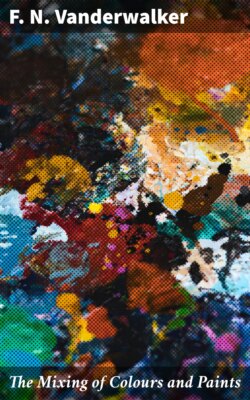Читать книгу The Mixing of Colours and Paints - F. N. Vanderwalker - Страница 15
BLUES
ОглавлениеAmong the blues used extensively by artists and decorators probably ultramarine, called French blue sometimes, is most popular. French blue is really ultramarine blue and is the most carefully prepared pigment of that series. It contains less sulphur than other ultramarines. French blue is especially valued for use with alizarine crimson to mix purples, having great plastic qualities.
Cobalt Blue.—Oxide of cobalt metal. It is very valuable since it possesses the most extensive utility among the sulphur blues. It is chemically stable and may be mixed with nearly all colors and white bases. When well made it has but a very small sulphur content. New blue has about the same appearance of purity of tone and is a less expensive cobalt blue. Cobalt blue is used extensively in ceramic manufacturing, for pottery, dishes and many other articles of merchandise. In the past its cost has been a bit higher than that of Prussian blue.
Cerulean Blue.—Related to cobalt blue and when made from the oxides of cobalt, zinc and chromium it is permanent and stable for mixing with other colors. It is sometimes gritty and hard to manage; also it possesses a tendency to turn to a greenish hue with age.
Cobalt Violet (cobalt purple).—A good pigment for use with ultramarine in mixing violets, making brilliant colors. Cobalt violet (or purple) is an excellent drying pigment which doesn't have much tinting strength, but is a good base for use with rose madder and others of the lake pigment class.
Prussian Blue.—Has a greater tendency to fade in strong light than other blues, but when used with other colors which form agreeable chemical combinations it is a valuable blue which is permanent. Faded Prussian blue regains its full color when placed in absolute darkness. Artists and decorators usually mix a Prussian blue color by adding emeraude green to ultramarine blue and a color permanent to light results.
Antwerp Blue.—A Prussian blue to which alumina hydrate has been added. The latter pigment is responsible for the translucency of Antwerp blue. Rather a permanent color except when mixed with lead colors like chrome yellows and American vermilion; it is likely to turn to a greenish hue when mixed with these colors. Antwerp blue is mixed by artists and decorators from ultramarine blue and emeraude green when a permanent color is needed.
Chinese Blue.—A Prussian blue of a slightly different hue.
Verditer Blue.—A light blue made from sulphate of copper; color used extensively at one time by the wall paper industry.
Mars Violet.—A selected and specially prepared form of yellow chrome which owes its color to oxide of iron. Rather slow to dry but permanent as to color and in mixtures except that it must not be mixed with lake colors.
Purple Lake.—Same as crimson lake with a variation of color.
